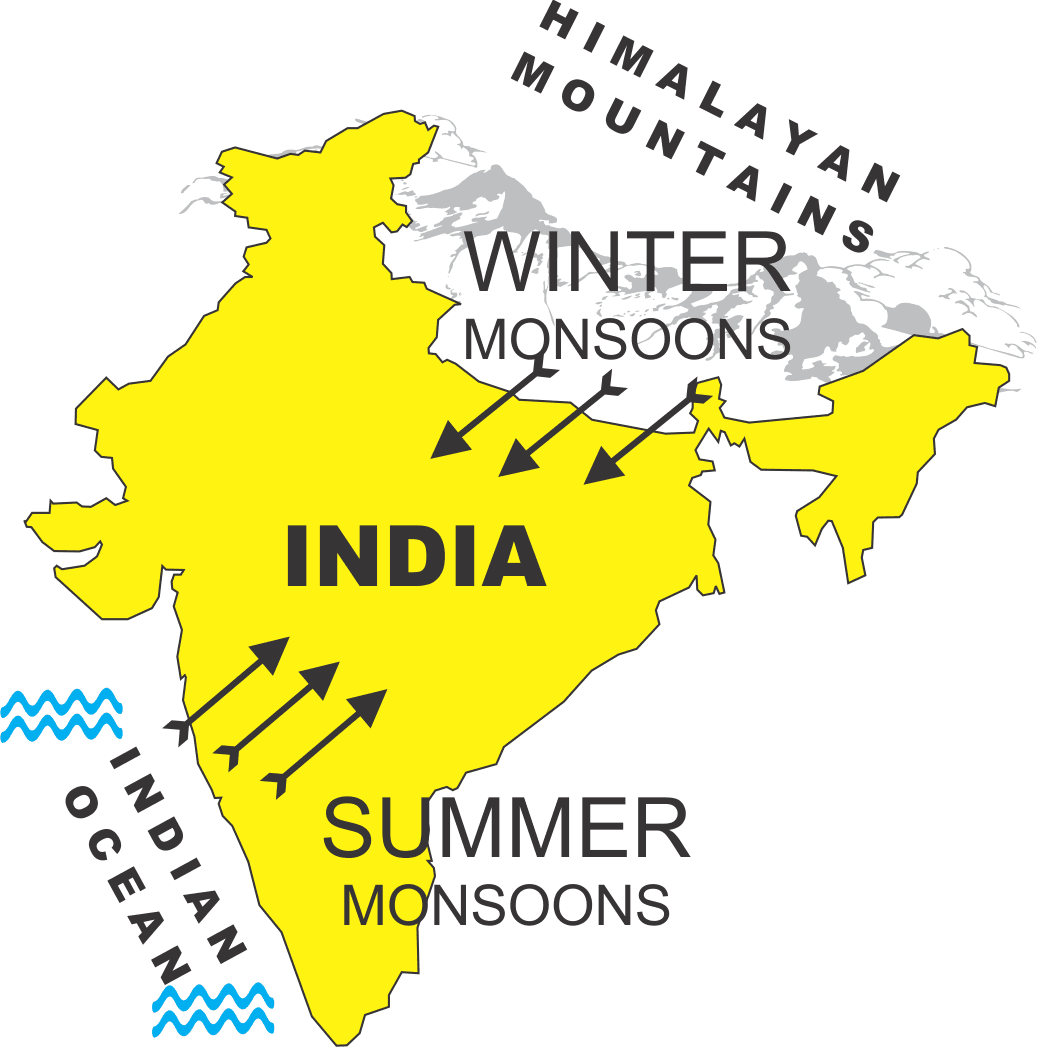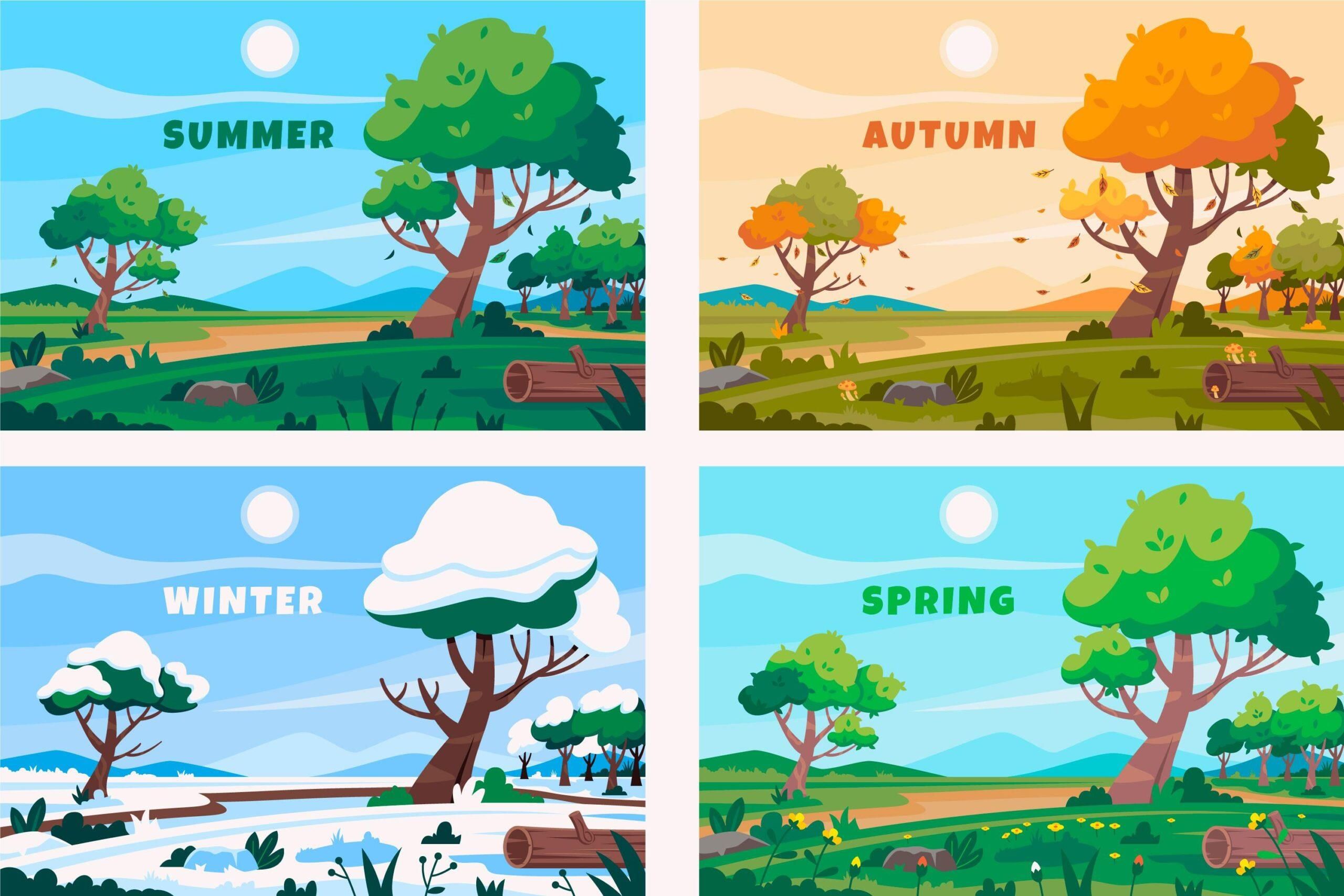Climate of India (Different Seasons) Chapter Notes | Social Studies Class 5 ICSE PDF Download
| Table of contents |

|
| Introduction |

|
| Climate of India |

|
| Effects of Climate on Human Life |

|
| Seasons in India |

|
| Points To Remember |

|
| Glossary |

|
Introduction
India is a big country with different types of weather in its many regions. The climate of a place means the usual weather it has over a long time, like 30 years. In India, the climate changes from one place to another because of things like where the place is located, how far it is from the sea, how high it is, and the monsoon winds that bring rain. This chapter tells us about how the climate in India changes in different areas, how it affects the way people live, and the different seasons India has, like summer, rainy season, winter, spring, and autumn.

Climate of India
- Climate means the usual weather of a place over a long time, like 30 years.
- India is a very big country, so the climate is not the same everywhere.
- Different parts of India have different types of climate.
- The monsoon winds play a big role in deciding the climate of India.
Regional Variations in the Climate of India
The climate in India changes from place to place because of these reasons:
Location of India
- India is in the northern part of the world, and the Tropic of Cancer passes through its middle.
- The southern part of India, which is closer to the Equator, stays hot all year round.
- In the south, the temperature does not change much between seasons.
- The northern part of India, which is farther from the Equator, has bigger temperature changes.
- In the north, it is much hotter in summer and much colder in winter.
Distance from the Sea
- India has a long coastline with places like Mumbai, Konkan, Chennai, and Goa near the sea.
- Places near the sea do not get too hot or too cold because of the sea's effect.
- The climate in coastal areas is mild, not extreme.
- Places far from the sea, like Delhi, Lucknow, and Bhopal, have very hot summers and very cold winters.
- Places away from the sea do not get the mild effect of the sea, so their climate changes a lot.
Altitude
- Altitude means how high a place is above the ground.
- Temperature gets lower as the height increases.
- Places in the mountains, like Leh and Srinagar, are cooler because they are high up.
- Places on the plains, like Delhi and Jaipur, are warmer because they are lower down.
Physical Features
- The Himalayas are tall mountains in the northern part of India.
- The Himalayas stop the cold monsoon winds from coming into India.
- These mountains also cause a lot of rain and snowfall in the Himalayan areas.
- In some parts of the country, the rainfall is not the same everywhere.
- Some areas get a lot of rain, while others get very little rain.
Effects of Climate on Human Life
- The climate of a place affects how people live in that area.
- It changes the type of food people eat, the clothes they wear, the houses they live in, and the work they do.

Food Habits
- The climate of a place decides what kind of food people eat.
- In coastal areas of India, fish is a very popular food because it is easily available.
- In the southern parts of India, the climate is good for growing rice, so rice is the main food there.
- Crops like Bajra are grown in Rajasthan because they can survive with less water.
- In Rajasthan, there is not much water, so crops that need less water are grown.
- In places with high altitudes, like Ladakh, the climate does not allow growing many food crops.
- In such high places, people eat more meat from animals because growing crops is hard.
Clothes
- In places where the climate is hot, people wear loose clothes made of cotton.
- Cotton clothes are light and comfortable in hot weather.
- In colder places, people wear warm clothes made of wool to keep themselves warm.
Shelter
- The type of houses people build depends on the climate of the area.
- In places with heavy snowfall and rain, like Jammu, Kashmir, Himachal Pradesh, Goa, and Kerala, houses have sloping roofs.
- Sloping roofs help rainwater and snow slide off easily so the house does not get damaged.
- In hot and dry places like Rajasthan, houses have thick walls and flat roofs.
- Thick walls keep the house cool in the hot climate.
- In some areas like Assam, where there is a lot of flooding, houses are built on stilts.
- Stilts are long pieces of wood or metal that lift the house above the ground to keep it safe from floodwater.
Occupations
- The climate of a place also affects the kind of work people do.
- In areas with a climate good for farming, most people work in agriculture.
- In coastal areas, many people work as fishermen because fishing is popular there.
- In the winter months, when it is not easy to go outside, people in Kashmir stay indoors.
- During winter in Kashmir, people do indoor jobs like making carpets and handicrafts.
- In the mountains, where farming is not possible, people raise animals for milk, meat, and skin.
- Animal rearing is a common job in mountainous areas because the climate is not good for growing crops.
Seasons in India
- Seasons are the different times of the year when the weather changes.
- In India, the main seasons are summer, winter, and rainy (monsoon).
- There are also short seasons of spring and autumn in India.

Summer (Hot Weather Season)
- Summer in India starts in April and lasts until June.
- During summer, the days are longer and the nights are shorter.
- In some parts of India, like the plains, deserts, and plateaus, it gets very hot.
- Hot and dry winds called "loo" blow in the desert areas and northern parts during summer.
- In the desert areas and northern parts, these hot winds can continue until late evening.
- Being in these hot winds for too long can make people sick.
- In May, dust storms are very common in northern India, especially around places like New Delhi.
- These dust storms bring cooler weather for a short time and sometimes light rain.
- The mountains in the north stay cool and pleasant during summer.
- Coastal areas are also cooler than the plains because of the winds blowing from the sea.
Rainy (Monsoon) Season
- The rainy season in India starts in June and lasts until September.
- During this time, monsoon winds blow from the Bay of Bengal and the Arabian Sea.
- These winds carry a lot of moisture and bring rain to the whole country.
- However, the amount of rainfall is not the same everywhere in India.
- Some areas get a lot of rain, while others get very little rain.
- Coastal areas and north-eastern states in India get heavy rainfall.
- Places like Ladakh and western Rajasthan get very little rainfall.
- Mawsynram in the Khasi Hills of Meghalaya gets the highest average rainfall in the world.
- India is a country that depends a lot on farming, and agriculture needs rain to grow crops.
- Because of this, the rainy season is the most important season in India for farming.
Winter (Cold Weather Season)
- Winter in most parts of India starts in November and lasts until February.
- In winter, the nights are longer than the days.
- December and January are the coldest months of the season.
- Temperatures decrease as you go from the south to the north of India.
- In northern India, there is extreme cold during this season.
- In the mountains of North India, like Shimla, there is snowfall during winter.
- The northern plains also have low temperatures during winter.
- In coastal areas, the weather is pleasant, neither too cold nor too hot.
- South India does not have very cold winters because it is closer to the Equator.
Spring Season
- Spring is a short season in India.
- It starts by the end of February and lasts until the end of March.
- The festival of Holi is celebrated to mark the end of winter and the start of spring.
- Spring is a time of pleasant weather in India.
- During spring, plants and trees get new leaves, and flowers bloom beautifully.
- In places like Sikkim, flowers like rhododendrons bloom during spring.
Autumn Season
- Autumn is also a very short season in India.
- It starts around the beginning of October and lasts for about a month before winter begins.
- The weather in autumn is cool and pleasant.
- This is the season when festivals like Durga Puja and Dussehra are celebrated in India.
- In places like Srinagar, autumn is a beautiful time with changing colors of leaves.
Fun Fact
The word "monsoon" comes from the Arabic word "mausim," which means season.
Points To Remember
- Climate means the usual weather of a place over a long time, like 30 years.
- India is a large country, so its climate is different in different parts.
- The climate in India is affected by its location, distance from the sea, altitude of places, monsoon winds, and physical features like the Himalayas.
- The climate affects how people live in India, including the food they eat, the clothes they wear, the houses they live in, and the work they do.
- The main seasons in India are summer, winter, and rainy (monsoon), with short seasons of spring and autumn.
- Summer in India usually starts in April and lasts until June.
- The rainy season in India starts in June and lasts until September.
- Winter in most parts of India starts in November and lasts until February.
- Spring in India starts by the end of February and lasts until the end of March.
- Autumn in India starts around the beginning of October and lasts for about a month before winter begins.
Glossary
- Precipitation: Water that falls from the clouds to the ground, like rain or snow.
- Lifestyle: The way a person lives.
- Scant: Very little and not enough.
- Sloping: Inclined or tilted.
- Stilts: Long pieces of wood or metal used to support a building so that it is above the ground.
- Animal rearing: Raising animals for their use.
- Exposure: Not covered or not sheltered.
|
88 docs|20 tests
|
FAQs on Climate of India (Different Seasons) Chapter Notes - Social Studies Class 5 ICSE
| 1. What are the main seasons in India and how do they affect daily life? |  |
| 2. How do regional variations in climate impact agriculture in India? |  |
| 3. What effects does climate change have on the seasons in India? |  |
| 4. How do different climates across India affect the lifestyle of its people? |  |
| 5. What role do the seasons play in Indian festivals and cultural practices? |  |




















